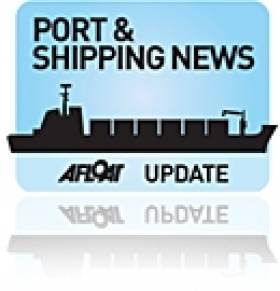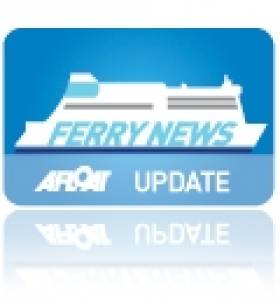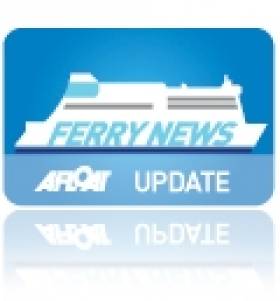Displaying items by tag: IOM Steam Packet Co
Isle of Man New Operator to Miss March Deadline
#ManxLink - According to BBC Isle of Man,Elann Vannin Line which attempted to establish a ferry service between the Isle of Man and England has confirmed it will not be able to start in March.
Owners of Ellan Vannin Line, Sea Alliance, announced its plans last year, stating it would be an "alternative to the existing monopoly".
All island operations are currently handled by the Steam Packet Company.
Sea Alliance head Kurt Buchholz said he had submitted an application to the Manx government but heard nothing back.
IOM Steam Packet Rivals Issue Ultimatum to Manx Government
#ManxLink - Captain Kurt Buchholz, founder of Ellan Vannin Line, has said that he has given the government a week to come back with a response to his application. He has indicated that if port authorities don't come back with the answers he wants, then: 'We might lose interest in proceeding further'.
He added: 'The government's slogan "Where you can" is a big joke.'
Captain Buchholz said an announcement will be made on Thursday this week about EVL's plans for a roll-on, roll-off daily cargo service between Douglas and Heysham, which he had hoped to launch at the end of March - and about its proposals for a TT passenger service.
The IOM Today.com has more on this story, click here.
I.O.M. Steam Packet Company Secure Charter of Seatruck Freighter
#NEWManxFreighter – In a move to further consolidate freight-service operations, the Isle of Man Steam Packet Company has chartered Seatruck Ferries R-class ro-ro freighter Arrow (1998/7,606grt) on a long-term basis, writes Jehan Ashmore.
The agreement includes an option to purchase the 84-truck trailer capacity vessel should this be necessary. The charter of Arrow provides the Isle of Man Steam Packet Company with a long-term back-up for its vital freight services, as well as guaranteed additional capacity to help grow the TT Races and Isle of Man Festival of Motorcycling.
With the introduction of Arrow, the additional freight comes at a time when Ellan Vannin Line, as previously reported on Afloat.ie, a new Manx based shipping company aim to introduce a rival freight service to the UK mainland in the first quarter of 2014.
According to the Ellan Vannin Line website, they also plan to start a IOM-UK ro-ro ferry service in readiness for the TT Races next year. Currently the IOM Steam Packet Company are the only operator of all passenger services that link ports to Heyham, Belfast, Dublin, Liverpool and Birkenhead.
Chief Executive Mark Woodward of the Steam Packet said: "MV Arrow is one of a class of vessels ideally suited to Steam Packet Company needs and the services we provide. Vessels which are suitable for operation in all weathers and at all states of tide in both Douglas and Heysham harbours are now becoming increasingly scarce. In recent years it has proven difficult to charter vessels for the short period necessary to either cover the Ben-my-Chree overhaul or simply to provide extra capacity at TT."
Mr. Woodward added: "In the short-term the charter will allow certainty in planning for the scheduled biennial overhaul of Ben-my-Chree in April 2014. It will also enable us to plan ahead and to devote the Ben-my-Chree fully to visitor traffic for next year's TT event, while the MV Arrow provides a bespoke and uninterrupted service for our freight customers."
Chairman Robert Quayle concluded: "We have been concerned for some time now at the falling number of suitable vessels available to us on the charter market. As a result of the recently announced debt reduction, the Steam Packet Company is now well placed to be able to implement key strategic developments for the future."
The company's main vessel the ro-pax ferry Ben-my-Chree. The 12,504 tonnes ferry has been the island's workhorse having provided 15 years of loyal service since introduction in 1998 primarily on the Douglas-Heysham route.
She also operates during Bank Holiday periods running sailings on the seasonal-only route to Dublin, with the balance of summer crossings covered by fast-craft Mannanan. Next month she is to resume operating winter-only sailings on the route to Birkenhead (Liverpool).
In those 15 years of service Ben-my-Chree has carried the equivalent of the Island's population 45 times over and enough freight to reach from Douglas to Birkenhead and back more than 20 times.
The sixth company vessel to carry the name Ben-My-Chree, has carried around 3.9 million passengers, 1.1 million cars, 250,000 motorcycles, and more than 100,000 vans and trade cars.
Freight is measured in metres in which her vehicle decks total 1,235 lane metres and it is estimated she has carried 6.2 million metres of freight. She has moved approximately 500,000 freight trailers which has involved carrying everything from food to space capsules.
She has provided a vital link for the Isle of Man Island all year round, with an exemplary reliability record of 97.8% since January 2010.
The £25m Ben-My-Chree was custom-built built by the Dutch yard of Van der Giessen de Noord shipyard in the Netherlands, for the 'Steam Packet' which claims to be the oldest continually operating passenger shipping company in the world, having begun operations in 1830.
Manx-Dublin Weekends Seasonal Services
#ISLE OF MAN FERRY – On both weekends before and after Christmas, the Isle of Man Steam Packet Co. will be operating seasonal sailings on the Douglas-Dublin route.
A round-trip sailing will depart Douglas tomorrow (Saturday) at 19.30hrs with an arrival of the ro-pax ferry Ben-My-Chree in Dublin Port on (Sunday) just after midnight at 00.15hrs. The ferry will make her return departure to the Isle of Man, departing the Dublin Ferryport at 01.00hrs with an arrival at the Manx capital scheduled for 05.45hrs.
On the weekend after the festivities are over, the Isle of Man ferry is to repeat the round-trip, departing Douglas on Saturday 29 December (19.30) with arrival in Dublin Port on Sunday 30 December (00.15). The corresponding return sailing departs the Irish capital at 01.00hrs and docks in Douglas at 05.45hrs.
For sailing schedules including Manx-UK routes, click HERE.
































































